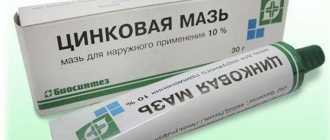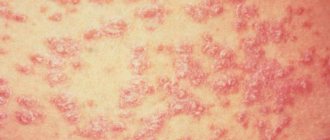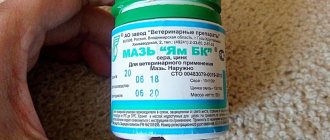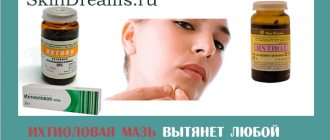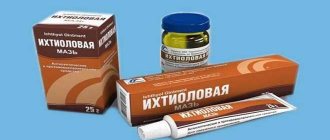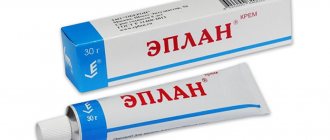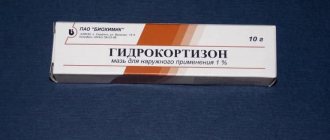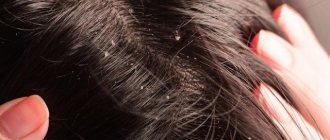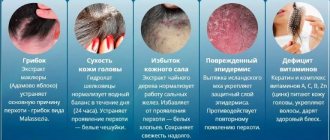Ichthyol – antiseptic
Ichthyol (or ingammol
, or in chemical terminology -
ammonium bituminous sulfate
) is a resinous substance from shale rocks. It is a concentrate of organic substances with a large amount of sulfur. Ichthyol is obtained by multi-stage processing of organic resin found in sedimentary shale rocks.
Note: the name “ichthyol” is translated from Greek as “fish” or “fish oil”. This is due to the fact that skeletal remains of prehistoric fish are often found in shales.
In the production of ichthyol, shale resins are sublimated and distilled, after which they are treated with alkali, sulfuric acid and ammonia water, after which they are evaporated and a medicinal substance is obtained.
It was introduced into treatment practice at the end of the 19th century by the German physician Paul Unna. The medicine was given anti-inflammatory, antiseptic and analgesic effects
. It was intended for external therapy of skin and joint diseases, inflammations.
Today, ichthyol ointment is a traditional remedy for the treatment of purulent wounds . It is available in a concentration of 10%
.
Treatment with ichthyol ointment is used in dermatology, urology, gynecology and veterinary medicine. At the same time, the veterinary composition differs in concentration ( 20%
instead of
10%
).
Ichthyol ointment 20%
has a more pronounced effect. Therefore, sometimes patients use the veterinary composition for a quick therapeutic effect. Ichthyol contains a lot of organic sulfur. Therefore, its effect is similar to sulfur ointment (also antiseptic and anti-inflammatory).
Ichthyol ointment base, release form
Despite the fact that ichthyol ointment is black in color and has a specific, unpleasant tar odor (which repels patients), the drug is often used in the treatment of many inflammatory processes. The basis of the medicine is ichthyol (determines the main medicinal properties of the medicine) and ordinary purified medical petroleum jelly (facilitates application and rubbing on the skin).
Ichthyol (ichthammol, ammonium bituminous sulfate) is an organic sulfur obtained by processing resin from sedimentary shale rocks.
The drug is available in two forms:
- Soft - ointment for external use, thick, dark brown in color, sold in glass jars or aluminum tubes. In pharmacies you can buy 10% and 20% composition. 10% contains 10 g of ichthyol and 90 g of medical vaseline. 20% ointment includes 20 g of ichthyol and 80 g of ordinary petroleum jelly.
- Solid - suppositories (rectal or vaginal) for the treatment of infections and inflammations in the pelvic organs. In addition to ichthyol, an additional component is vitepsol. The candles are cylindrical in shape, with a pointed end, and painted dark. Each suppository contains 200 mg of ichthammol, in a package of 2 cells of 5 pieces.
The drug is produced by domestic and foreign manufacturers.
The effect of ichthyol in ointment
Ichthyol ointment 10% is an effective drug for the treatment of skin and joint inflammation. How does the ointment work?
The active substance (ichthyol) inhibits the production of inflammatory mediators. In this regard, its effect is similar to the work of non-steroidal anti-inflammatory drugs, as a result of which joint pain is reduced and the development of inflammation is limited. In case of inflammation, ichthyol ointment acts as an analgesic - it reduces inflammation and reduces pain .
Ichthyol also slightly irritates the nerve endings, and this increases blood circulation and vascular tone in the area where the ointment is applied. As a result, the nutrition of tissues improves (in medical terminology, their trophism), the elimination of metabolic products is accelerated, and as a result, the area of inflammation decreases and the amount of pus (if any) decreases. Thanks to the tone of the vessels, their lumen narrows and the flow of fluid to the site of inflammation decreases. Which leads to a decrease in swelling.
Thus, ichthyol ointment draws out pus, treats inflammation on the skin (boils, dermatitis, post-burn redness) and in subcutaneous tissues (joints).
Treatment of inflammation has an effect on reducing pain. Therefore, ichthyol ointment is called not only an anti-inflammatory, but also an analgesic.
What is better Ichthyol ointment or Vishnevsky?
Ichthyol and Vishnevsky ointment are applied to the surface layers of the skin. But their indications for use differ significantly. Vishnevsky ointment is used to eliminate infectious and inflammatory processes. For example, an abscess, a boil. Ichthyol remedy - for severe inflammation and pain on the skin. For example, for burns, metritis, salpingitis. But some of the indications for use for both drugs are similar:
- burns;
- ulcers;
- wounds.
Vishnevsky ointment is used only externally on areas of the skin. Ichthyol agent can be used both externally and rectally. Common actions include identical contraindications and side effects. There are very few of them, so the drugs can be applied to almost every patient.
Both products are cheap. The maximum price for Vishnevsky ointment is 50 rubles, ichthyol - 60 rubles. Before using medications, you should carefully read the instructions. If there is an infection with penetration of pathogenic microorganisms deep under the skin, it is better to choose Vishnevsky ointment. For rectal and prostatic changes, buy ichthyol.
What is ichthyol ointment used for?
Ichthyol ointment in the instructions for use refers to antiseptic drugs. It exhibits a bactericidal effect primarily against gram-positive bacteria - Staphylococcus aureus, streptococcus . It also has some inhibitory effect against pathogenic fungi . Therefore, it is used to treat skin inflammations of bacterial and fungal origin, as well as joint pain.
Let's list what ichthyol ointment helps with and when it is used for external treatment:
- For skin infections (acne of various origins - boils, ulcers, acne, hidradenitis - purulent inflammation of the sweat glands in the armpits).
- For skin injuries (burns, frostbite) after primary epithelization.
Note: ichthyol ointment is not applied to an open wound. Therefore, it is not applied to open burn wounds, but is used after primary healing, the so-called primary epithelization.
- For allergic skin inflammations (eczema, dermatitis).
In gynecology, ichthyol ointment is used to treat inflammation (in the chest - mastitis, in the abdominal cavity - fallopian tubes, ovaries, uterus, as well as endometritis). In urology, ointment is used in the treatment of prostatitis.
Note: for inflammation of the pelvic organs, ichthyol rectal suppositories are used. They are introduced into the rectum, from where ichthyol is transported to the abdominal organs. This treatment is used in gynecological and urological practice.
In rheumatology, the ichthyol composition is used to reduce the area of inflammation in joint pain (arthritis, neuralgia of any origin).
Medicinal properties of the drug
The main component of ichthyol ointment is ichthyol, an oil that is treated with sulfuric acid. Thanks to the sulfur-containing compound, the following therapeutic effects occur:
- anti-inflammatory (relieving swelling);
- antiseptic, antibacterial (fighting bacteria);
- analgesic (local anesthetic - reducing pain at the site of application);
- keratoplasty (softening and rejection of the top layer of skin and the formation of a new epidermis);
- antifungal (therapeutic effect for fungal infections);
- sebum-regulating (preventing the development or combating increased sebum secretion).
The medication also improves blood microcirculation in the skin in the area of application, toning blood vessels, accelerating tissue regeneration, and promoting the rapid restoration of tissue structures and functions. Through external use of ichthyol ointment, which contains ichthammol and petroleum jelly, any inflammatory and infectious skin diseases are treated. The ointment reduces the severity of the inflammatory reaction, relieves pain, destroys the causative agent of infection, accelerates the elimination of metabolic products, which promotes a speedy recovery. After applying the ointment to an open wound, the blood vessels narrow, which reduces the production of pus, promotes cleansing of the injured area and subsequent healing.
Suppositories are used as complex therapy for the pelvic organs (urological, gynecological, proctological). Ichthammol is not absorbed into the systemic bloodstream, but has a local effect, relieving the inflammatory process and pain. The functions of ichthyol are similar to NSAIDs and analgesics.
Due to the local effect, the drug does not reduce the speed of the psychomotor reaction, therefore, during treatment it is allowed to drive a vehicle and other mechanisms that require concentration.
Ichthyol ointment for boils and ulcers
The main property of ichthyol ointment is manifested as the ability to draw out purulent exudate. Ichthyol ointment for abscesses is used to accelerate the “ripening” of the boil (if abscesses have formed and are not in a hurry to ripen, they sit deep and hurt).
The use of ichthyol ointment for abscesses can speed up the process of abscess formation. It accelerates its tension and subsequent breakthrough. After which the pimple is carefully burned with alcohol .
Note: if the pimple is small, it may “disappear” without ripening. In this case, the pus from the ichthyol ointment simply resolves, and an abscess does not form.
Ichthyol ointment for acne
Ichthyol ointment helps improve the appearance of skin with purulent acne . She pulls out pustules from the deep subcutaneous layer. And this accelerates their maturation and treatment. How to use ichthyol ointment for cosmetic purposes?
- Acne removal - after pulling the pimple, if it has not opened on its own, it is squeezed out or pierced with a needle. Afterwards, the pus is removed and treated with an antiseptic. If necessary, apply ichthyol ointment again. When the pus has completely drained, epithelization (healing) of the skin tissue occurs.
- Cosmetic facial cleansing - ichthyol is applied to the face for 30-40 minutes. A mask of ichthyol ointment shows where inflammatory processes are still occurring and require repeated “cleaning”.
Note: in addition to the cosmetic “cleansing” procedure, in other cases it is not recommended to apply ichthyol ointment to the entire face. It is better to use it point-wise - exclusively on pimples, comedones, boils, and abscesses.
Ichthyol also draws out the contents of clogged sebaceous ducts (comedones).
- Removing blackheads - with oily skin, the sebaceous ducts are buried with the so-called “plug”. It creates the appearance of a black dot. An accumulation of blackheads on the nose, cheeks, cheekbones, and in the nasolabial triangle is called acne. Ichthyol dissolves sebaceous plugs and removes the contents of the duct out. Thus, the cosmetic effect of ichthyol ointment against blackheads is manifested.
- Ingrown hair treatment - uses the ability of ichthyol ointment to remove dirt and grease. Anti-acne agents are often used for therapy. They dissolve the sebaceous fat accumulated in the hair follicle. Thus, ichthyol ointment for ingrown hairs allows the hair to grow outward rather than inward.
- Treatment of chalazion - the ability of ichthyol to unclog sebaceous ducts is also in demand. This disease is associated with inflammation of the sebaceous gland on the eyelid, its blockage and the formation of a compaction or tumor. For chalazion, ichthyol ointment is applied from the outside next to the eyelid (so as to prevent it from coming into contact with the cornea of the eye). It pulls out the formed “barley” and treats inflammation.
Important: after a purulent formation breaks through, the rod must come out when treating a chalazion. Only then will the recovery be complete.
Rules for using the drug
The method of using ichthyol ointment is simple - it is only important to choose a convenient form and concentration of the active substance.
WE RECOMMEND THE ARTICLE!
Penzital helps facilitate the process of digestion of food. Read more >>
A mask is often made from the ointment, combining ichthyol with glycerin. Before applying, you need to cleanse your face of makeup and dirt. Apply 10% or 20% composition (depending on medical advice) in a thin, even layer and leave for 30 - 40 minutes. If the procedure takes place in a beauty salon, it is better to carry out the darsonvalization method on a dried mask, and then rinse off the dry ointment with clean warm water.
Also, for skin diseases or joint lesions, lotions and applications of ichthyol with glycerin are effective. To make it, you will need to mix them in equal proportions until a homogeneous mass is obtained, apply a thin layer to the site of inflammation and rub in until you feel warmth. Lotions are made 2 - 3 times a day, and bandages are changed daily.
Treatment of boils with medication can be done at home.
The ointment is applied in a thin layer to the affected skin area twice a day. It is necessary that the product completely covers the boil or part of the skin around it. The use of the medicine accelerates the maturation of the boil, prevents the addition of a secondary infection and the spread of pus over the surface of the skin. After opening the abscess, the healing of the skin is stimulated. The use of “ichthyolka” is allowed for children of any age. The main thing is to make sure that the child does not remove the bandage and swallow the product.
Ichthyol ointment also helps against lymphadenitis. Algorithm of action in the treatment of pathology in which the lymph nodes become inflamed:
- the medication should be applied in a thin layer to the site of inflammation twice a day;
- compresses are also used (for cysts on joints, abscesses) - squeeze the product onto a clean cloth or gauze, apply to the affected area for 1 - 2 hours;
- duration of therapy with ichthyolka! — no more than 7 days;
- During treatment, it is forbidden to heat and massage the lymph nodes - in the presence of a purulent process, there is a risk of pus spreading beyond the node, as a result of which neighboring tissues are affected;
- if the swelling does not go away, you need to urgently consult a doctor - sometimes local treatment is not enough and it is necessary to look for the cause of the disease, and not to eliminate the symptom.
As for the use of suppositories, they are inserted deep into the vagina like a tampon (vaginally) or the rectum (rectally). Insertion into the anus requires complete bowel movement (this can be done with a cleansing enema). The dosage is prescribed by the doctor individually, depending on the severity of the disease.
Ichthyol ointment and wen
For the treatment of so-called wen, the success of therapy depends on how completely it was possible to pull out the contents of the fat capsule from under the skin (its internal exudate and membrane (capsule))
.
If treatment consists only of removing the contents of the capsule, then after some time the wen will form again .
When wen forms under the skin, ichthyol ointment is used as an additional means of external treatment. It reduces inflammation after puncture, laser correction, and radio wave removal.
Ichthyol ointment in gynecology
Ichthyol ointment has found application in gynecology. How to use ichthyol ointment to treat female genital organs?
The ointment composition is used in the form of tampons. You need to know that ichthyol, according to the instructions, is not applied to mucous surfaces . Therefore, when inserting tampons with ichthyol ointment into the vagina, the ointment is diluted with glycerin . In addition to glycerin, ichthyol ointment for tampons can be diluted with camphor oil . Dilution of ichthyol ointment reduces the concentration of ichthyol and reduces irritation of the mucous membrane.
Due to the irritating effect of ichthyol on the vaginal mucosa, sometimes tampons are inserted into the rectum (through the anus). From the rectum, ichthyol will enter the local bloodstream inside the small pelvis and through it to the inflamed female genital organs.
Note: ichthyol ointment cannot be used for cervical erosion. It can increase irritation and inflammation. Also, due to irritation of the mucous membrane, do not apply regular ichthyol ointment without dilution to the lip or inside the nose.
Glycerin itself also has some effect. It increases the secretion of mucus in the cervix and thereby speeds up the cleansing of the vagina from pathogens. This is why tampons with ichthyol ointment cause profuse mucous discharge from the vagina.
Choosing the best antiseptic
There are no absolute analogues of ichthyol ointment - there are no preparations with the active ingredient ichthyol. However, there are other antiseptic agents with similar therapeutic effects. For a detailed overview of generics, please refer to the table:
| A drug | Active substance | Manufacturer | Average price in Russia in rubles |
| Vishnevsky ointment (Balsamic liniment) | Xeroform | Belarus | 45 |
| Levomekol | Chloramphenicol and methyluracil | Ukraine | 117 |
| Zinc paste | Zinc oxide | Russia | 58 — 79 |
| Dimexide | Dimexide (dimethyl sulfoxide) | Russia | 40 — 157 |
| Furazolidone | 3 (5 - nitro - 2 - furanyl) methylene - amino - 2 - oxalidinone | Russia | 56 — 111 |
| Sinaflan ointment | Fluocinolone acetonide | Russia | 55 — 85 |
| Kelo-cote | Polysiloxane and silicon dioxide | USA | 892 — 1007 |
| Elon | Turpentine oil (turpentine, turpentine) | Germany | 945 |
| Undecin | Undecylenic acid | Ukraine | 674 — 715 |
| Fusiderm | Fusidonic acid and betamethasone | Russia | 419 |
Analogs are used only when immune responses appear due to the use of ichthyol ointment.
Often at the pharmacy they ask what is better - Levomekol, zinc paste, Vishnevsky ointment or “ichthyolka”. It all depends on the type of disease. For example, Levomekol has a more pronounced antiseptic effect, therefore it is especially effective in the treatment of open wounds. Zinc paste is most often used to treat dermatoses, dermatitis, and prevents the active proliferation of microbes. The difference between Vishnevsky’s ointment and ichthyol ointment is only in price - liniment is much cheaper than ichthyol ointment.
It is impossible to say with certainty which drug is better. Medicines differ from each other in price, composition, and concentration of the active substance.
Ichthyol ointment for hemorrhoids
With developed hemorrhoids, protruding nodes (bumps) form in the anus. They often become inflamed and bleed. For their treatment, local wound healing agents (ointments) are used.
The ichthyol composition can be used as an external antiseptic. However, one must understand that the main effect of ichthyol ointment is antiseptic and disinfectant. It has almost no wound healing properties. Therefore, you should not hope that in case of hemorrhoids, ichthyol ointment will be able to stop bleeding and tighten bleeding cones.
Methods of using ichthyol ointment
Ichthyol ointment is used in pure and diluted form. The undiluted composition is used to treat boils and joint pain. Dilution of ichthyol is necessary when applying ointment to mucous membranes.
If dilution is necessary, ichthyols are mixed with glycerin or camphor oil (until a homogeneous mass), and then used in the form of lotions (for streptoderma) or tampons (for the treatment of gynecological inflammation).
Undiluted ichthyol ointment can be rubbed into the skin without a bandage or applied under a bandage (for long-term action). If used without a bandage, rub into the skin until a warm sensation appears . After which, they wrap the joint with a warm scarf to preserve heat and have a better therapeutic effect.
If you put the ointment under a bandage, then apply it to the skin without rubbing. This compress with ichthyol ointment is used both for the treatment of joints and for purulent boils.
Sometimes (for severe joint pain) ichthyol ointment for animals is used (20%
).
How to apply ichthyol ointment? For a compress, apply it in an even layer several millimeters thick. Afterwards, cover with gauze or other natural fabric .
And leave the ichthyol ointment overnight. How long to keep ichthyol ointment under the bandage depends on the extent of joint inflammation. Usually it is applied for 8-12 hours (evening + night time), and washed off during the day (ichthyol has a specific odor, so its use during the day can create some psychological discomfort)
.
Important: ichthyol ointment is not applied to the wound. Therefore, you cannot use it to treat skin inflammations that are accompanied by wounds and bleeding, and you also cannot smear fresh cuts, burns and other skin injuries with ichthyol.
also not recommended to apply undiluted ointment into the eyes or onto any other mucous surfaces (nasal sinuses, oral mucosa, genitals).
Possible contraindications and side effects
You should be careful if you have individual hypersensitivity to the main or additional components of the drug. Typically, hypersensitivity occurs in people suffering from allergic reactions.
Ichthyol is applied with caution to mucous membranes or open wounds.
Despite the impressive list of indications, it is important to remember that ichthyol ointment is a drug, so there are the following contraindications:
- Some people try to “pull out” the wen with ichthyol. The fatty tumor (lipoma) is localized in a special capsule that the medicine cannot dissolve. Therefore, if you have symptoms of pathology, it is better to immediately consult a doctor and not waste time self-medicating.
- The drug does not treat post-acne - spots after acne. The drug penetrates into the deep layer of the skin - the dermis and interferes with tissue healing.
- You cannot combine “ichthyol” with other local medications, especially if the components of the medications are iodine, heavy metals, and alkaloids. Such combinations often lead to aggravation of the situation. interfere with tissue healing.
To avoid the development of allergic reactions, doctors and pharmacists advise performing a test on a small, least sensitive area of skin (on the elbow, behind the ear). It is better to carry out the test in the evening. If no rashes, swelling or redness appear in the morning, you can safely use the drug.
Coloring the skin dark is not a side effect, but is considered a consequence of using an ointment that contains tar. Therefore, if the color of the epidermis changes, the medication should not be discontinued.
[media=
https://youtu.be/MTUC5193Utc
]
Analogues of ichthyol ointment
The first analogue of ichthyol ointment is Vishnevsky ointment. It is often offered as a means of identical action. At the same time, it has some differences that make it possible to distinguish between the use of ichthyol and Vishnevsky ointment. What are they?
Ichthyol ointment or Vishnevsky ointment: which helps better against boils
Vishnevsky ointment is also an external antiseptic and is used to treat infected wounds. It differs in composition, containing birch tar and xeroform (disinfector, phenolic product). Ichthyol ointment tightens the abscess faster. Therefore, at the stage of its maturation, it is better to use ichthyol. After the abscess breaks through, you can switch to Vishnevsky ointment. It has stronger bactericidal properties, so it treats inflammation better than ichthyol ointment .
In addition, ichthyol is used to reduce joint pain. But Vishnevsky's ointment does not have a joint therapeutic effect .
Ichthyol ointment or Levomekol: comparison of composition and action
Levomekol is an ointment that contains the broad-spectrum antibiotic chloramphenicol and the wound-healing substance methyluracil. Levomekol is also intended for the treatment of skin inflammation, but does not have the property of “pulling out” pus . However, it has a stronger antibactericidal effect and the ability to accelerate the regeneration (healing) of skin tissue.
Levomekol allows you to treat severe inflammation. It is used for deep skin injuries and extensive purulent infections , applied to open purulent wounds. Ichthyol is more effective for local purulent formations (boils, pimples).
Combined treatment uses both ointment compositions. First - ichthyol ointment (to draw out pus from deep tissues). And after – Levomekol (for effective treatment of inflammation and rapid epithelization).
Indications for use of ointments and suppositories
Initially, a product based on ichthyol could only be purchased in the form of an ointment and used to treat dermatological pathologies. However, over time, the thick substance worked well, so the medicine was released in a more convenient form - in the form of suppositories. Candles are easy to use and have a more effective effect on the pelvic organs.
The drug is applied externally to the skin for the following ailments:
- burns, frostbite;
- psoriasis;
- systemic lupus erythematosus.
Ichthyol ointment is widely used in cosmetology for the preparation of various masks. The most common task of a cosmetologist is facial treatment: eliminating acne, blackheads, and fatty spots. Ichthyol and medical petroleum jelly in the composition of the drug relieve pain and are effective against inflammation. To eliminate skin lesions, these are the most important aspects, because it is important to have a comprehensive effect on the epidermis. The medication draws pus out of pimples - it acts on the inflammatory process from the inside, and not from the outside.
Cosmetologists advise people with problem skin to buy or make their own ichthyol soap. The product was created to care for oily, seborrhea-prone skin and is effective against acne. How much soap to use depends on the problem the person is facing. For example, blackheads are eliminated within a month of constant use.
Ichthyol ointment is also effective for bruises, arthritis, arthrosis and other joint lesions, fractures of a finger, arm, leg, festering splinters, ingrown nails, insect bites, neuralgia caused by injury or inflammation of the nerve.
In the treatment of skin lesions, preparations based on ichthyol and zinc crystals have shown good results, one of them is zinc-ichthyol ointment.
As an internal treatment, suppositories are used for the following infectious and inflammatory diseases in gynecology:
- adnexitis, metritis, parametritis;
- vaginosis, colpitis, cervicitis;
- salpingitis, endometritis.
Moreover, suppositories based on ichthammol are effective for prostatitis, hemorrhoids, and anal fissures. Suppositories and ointment are allowed during pregnancy and breastfeeding due to their local effect only.
Reviews
Svyatozar, Kalachinsk
An old well-known remedy. You apply it to an infected wound - by the morning it becomes larger, the abscess fills. At first it seems terrible, it has become very bad. Then the pus comes out and everything heals quickly. Ichthyol ointment strongly draws pus to the surface of the skin.
Yulia, p. Myshkin If the abscess is small, you can pull it out. And if the wound is large, the pulling of pus will be too strong. I had a small wound from a hangnail. It started to fester. She smeared it with ichthyol and cured it in a couple of days. But when there was a big cut on the entire finger, and it so happened that it became infected, she no longer dared to smear it with ichthyol. It will swell your whole arm. She smeared it with levomekol and dimexide and wrapped it with a bandage on top.
Gennady, Yekaterinburg I often use ichthyol ointment for acne - I apply it to each pimple in the evening, cover it with a bandage and plaster, and leave it on all night. In the morning, either the pimple has already opened, or I pierce it with a needle and burn it with alcohol.
